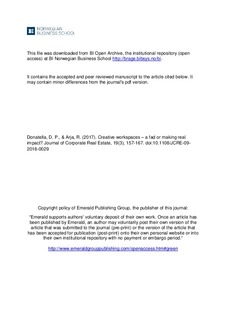Creative workspaces - a fad or making real impact?
Journal article, Peer reviewed
Accepted version
Permanent lenke
http://hdl.handle.net/11250/2489041Utgivelsesdato
2017Metadata
Vis full innførselSamlinger
- Publikasjoner fra CRIStin - BI [1015]
- Scientific articles [2181]
Sammendrag
Purpose The purpose of this paper is to explore the current trend of designing workspaces to foster creativity. The paper brings forth themes that seem to be connected with the so-called ‘creative workspaces’. The paper discusses how the findings relate to recent theory and research. Finally, the paper develops propositions to further elaborate the issue. Design/methodology/approach The paper adopts an inductive and social constructionist approach. In all, 40 internet pictures of workspaces claimed to be creative among a broad range of industries and companies which were analyzed through an aesthetic lens and compared to what theory and research about organizational creativity and space inform us. Findings The designs of ‘creative workspaces’ follow a rather standardized and deterministic assumption of what kind of spaces are considered to produce creativity: open offices, happy, playful communities of close-knit teams and spatial arrangements that resemble home, symbols and memories, sports, technology and nature. This view of creativity and workspaces remains a management fad unless a more balanced approach to the issue is assumed. Research limitations/implications The sample is not to be representative and the findings generalizable as such, but to bring forth the phenomenon. This exploratory and inductive approach calls for a systematic study to prove the propositions in a more controlled research setting and with a bigger sample. Practical implications The paper makes a few suggestions of what companies should pay attention to when building workspaces to improve organizational creativity – and to overcome the fad. Social implications The proposed end-user perspective may ultimately save costs, if people can voice their needs on the space arrangements from the beginning and throughout the building process, not only after the spaces are fully complete, as is typically the case. Originality/value The paper provides a critical view on the trend of building work spaces to purposefully enhance organizational creativity. It brings forth themes that are connected to creativity and workspace designs and suggests that more nuances are involved in the issue.
